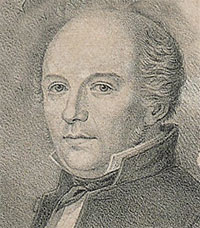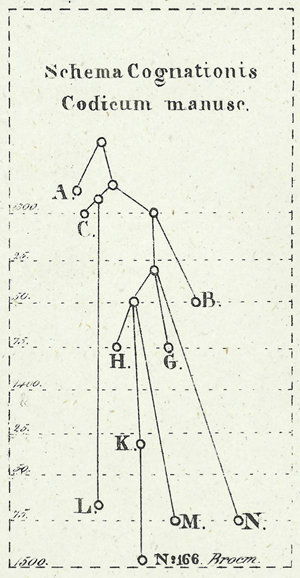Schlyter, Carl Johan
Carl Johan Schlyter (Karlskrona, 1795 – Lund, 1888) was a Swedish scholar who made an outstanding and long-serving contribution to the editing of mediaeval Swedish laws (ill. 1). He was one of the first scholars in Sweden to receive the degree of juris doctor, and was appointed docent at the University of Lund as early as in 1816 and later became professor, first in Uppsala and a few years later in Lund. With his fellow student Hans Samuel Collin (1791–1833) he was appointed editor of the Samling af Sweriges gamla lagar (Corpus juris sveogothorum antiqui). The first volume of this large-scale edition was of the Westrogothic law, Vestgötalagen (1827), and after Collin died, Schlyter continued the editing on his own, bringing the series to its conclusion with vol. 13 in 1877.
A remarkable trait of the very first volume is a stemma of the manuscripts, added in the appendix (ill. 2). This is in many ways a modern stemma, and it is also probably the first stemma ever published, more developed than the earliest, sketchy stemmata drawn by classical scholars on the continent a few years later.
The stemma in Vestgötalagen seems to have been isolated at the time, nor was it known to Sebastiano Timpanaro in the first edition of his La genesi del metodo del Lachmann (1963), but after the publication of an article in English by Gösta Holm (1972), it has made its way in the general stemmatological literature, and is discussed e.g. in the latest edition of Timpanaro’s work (ed. Most 2005, 92–93).
The stemma in the edition of Vestgötalagen is not specifically attributed to either of the two editors, Schlyter and Collin. Britta Olrik Frederiksen has investigated the background of the stemma construction, and her conclusion is that it seems most likely that the stemma was Schlyter’s own contribution (2009, 139–148). It should be noted, however, that in spite of embellishing the edition with a stemma, the text of Vestgötalagen was not constituted in a Lachmannian sense of textual reconstruction, and Schlyter did not draw any stemmata for the following editions in the series.

Ill. 1. Carl Johan Schlyter (1795–1888)

Ill. 2. The stemma in the edition of Westgöta-lagen (1827, appendix) by Carl Johan Schlyter. He called it schema cognationis codicum manuscriptorum, or 'diagram of relationship of the manuscripts'.
Works by Schlyter
– Schlyter, Carl Johan, and Hans Samuel Collin, eds. 1827. Westgöta-lagen. Samling af Sweriges Gamla lagar, vol. 1. Stockholm: Häggström. – Note that this text has been scanned by Google Books, but for some reason they have not included the stemma, cf. http://books.google.no/books?id=aZgyAAAAIAAJ&redir_esc=y. Accessed 28 October 2015.
Works on Schlyter
– Frederiksen, Britta Olrik. 2009. “Stemmaet fra 1827 over Västgötalagen – en videnskabshistorisk bedrift og dens mulig forudsætninger.” Arkiv för nordisk filologi 124: 129–150.
– Holm, Gösta. 1972. “Carl Johan Schlyter and Textual Scholarship.” Saga och Sed 1972: 28–80.
– Timpanaro, Sebastiano. 1963. La genesi del metodo del Lachmann. Firenze: Monnier.
– ———. 1981. La genesi del metodo del Lachmann. 2nd ed. Padova: Liviana.
– ———. 2005. The Genesis of Lachmann’s Method. Translated by Glenn W. Most. Chicago: University of Chicago Press. – Translated from Timpanaro 1981.
OH